Introduction
In this part we will be discussing the other products that are manufactured through the mevalonate pathway namely Dolichols, Sterol,, Heme A, and prenylated proteins.
Both Coenzyme -Q10 and Dolichols discussed in the next section are considered both as part of the cell’s antioxidant defense system.
As stated in a a 2015 article published by the International journal of molecular science that one study showed that Simvastatin in lung cancer cells inhibited the proliferation, and increased significantly, oxidative stress, augmenting reactive oxygen species production and the activity of superoxide dismutase.
Dolichols
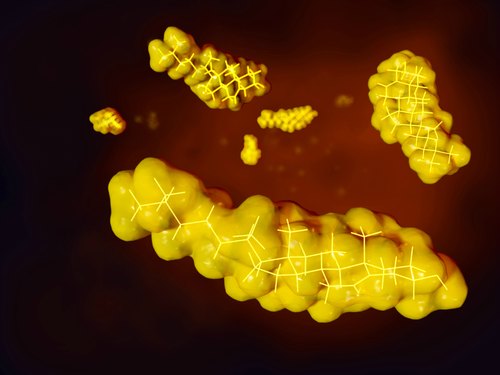
Dolichols protects cellular membranes
Dolichols provide outer cell membrane integrity, and since dolichols are part of the membrane structure, they act as a form of lining.
The Dolichol acts as an ‘armor shield’ by preventing cell damage by providing the membrane with resilience, flexibility and permeability.
Dolichols also acts as free radical scavengers in the cell membranes and Ciosek and colleagues observed a significant decrease in dolichol levels after Lovastatin administration in vivo models causing oxidative stress and mitochondrial damage.
Dolichols and Glycoprotein synthesis
Dolichols are involved in Glycoprotein synthesis.
Glycoproteins contain a sugar molecule and inhabit in and around a cell’s membrane.
Glycoprotein synthesis begins within the cellular Endoplasmic Reticulum, which is the site where proteins and sugars attach.
These Glycoproteins have various functions, including Immune system WBCs, that hunt down potential invaders and attach themselves to the blood vessel lining through glycoproteins called Lectins.
The Glycoprotein molecule on red blood cells are ID markers that immune system cells read to ensure that they are its host cells and not foreign antigens, and these proteins also assist as an anticoagulant.
Protective mucus in parts of the body are made of Glycoproteins, in addition to protecting the skin.
Dolichols and Protein delivery
One of their functions is to help direct proteins to targeted cells, so when the liver or other tissue produce certain proteins they need to be delivered to specific destinations, and if this process is impeded, chaos reigns within the body similar to navigating your way around a city without street signs or addresses.
Dolichols and Autophagy (Cell recycling)
Dolichols serve a special purpose in the cellular Lysosomes which are walled off rooms near the nucleus of the cell that contain cell debris from damaged cell parts and digestive enzymes that assist in breaking the debris down for cellular parts recycling.
These particular enzymes require an acidic environment to complete their task and lysosomes provide it, by using dolichols to pump hydrogen ions into the lysosomes.
Autophagy is tied to numerous molecular mediators called Autophagy Related Proteins including Prenylation Proteins that seem to be key regulation mechanisms.
These proteins will be discussed in the next section.
Finally, with dysfunctional lysosomes that are unable to digest cellular debris, the residue that remains is ‘Lipofuscin’, characterized by accumulative brown spots on the back of the hands, colloquially named ‘Age spots’. Lipofuscin is a product of unsaturated fatty acid oxidation indicative of cellular membrane damage, which is occurring all over the body.
Dolichols and Neuropeptides
Particular glycoproteins are transported to the Golgi apparatus for packaging into vesicles ready for transport to nerve axon storage, within the vicinity of synapses junction in the brain, where they will remain until needed for release as a reaction to an emotional event.
There are reports of tension and aggression linked to Statins but very few, let’s face it, if I were taking a drug that is making my muscles ache, I think I would feel pretty miserable as well. One case was reported with the use of Vytorin which is a cholesterol lowering drug that contains both a combination of Ezetimibe and Simvastatin:
“My husband was prescribed Vytorin® 3 months ago and has been experiencing severe side-effects from it. Within a month of taking this drug, his personality began changing. He has become easily agitated, and he is growing more and more hostile and aggressive when upset. Frankly, I don’t like the person he has become. He is paranoid, unable to focus clearly, has no sexual interest and does not remember many things that I have told him. After reading the content on your website and several others, I am convinced that Vytorin is toxic to his system.”
The first randomized blind study involving 1000 adult men and postmenopausal women by the UC San Diego school of medicine looked at Statin effects on behavior using Brand name drugs Simvastatin and Pravastatin for 6 months.
Behavioral aggression was measured using a weighted tally of actual aggressive acts against others, self or objects.
Other measurements included testosterone levels and sleep problems, both of which have an effect on aggression.
Researchers found that in the women aggression increased , but in the men it decreased, apart from 3 men who displayed a heightened level of aggression.
Other observations revealed a larger drop in testosterone on Simvastatin that was linked to a greater drop in aggression, but in terms of sleep problems, aggression increased on this drug.
The lead author of the study Beatrice Golomb MD stated that many studies have linked low cholesterol to increased levels of violence and death from suicide, accident or homicide but overall there are some inconsistencies.
To me the outcome of this study is somewhat enigmatic since it is well known that frontal lobe physiology is greater in women than in men, which is the primary reason men are more prone to violence than women, I mean, apart from Boadicea, Joan of Arc and Cleopatra most wars have been initiated by men.
You see some of us men cannot control ourselves which is why we need women pacifiers, that is why I believe women are the superior gender…how many men would be able to tolerate labor or pre-menstrual cramps every month..we would all be killing each other…maybe men should take Statins just to control aggressive behaviour.
Beatrice Golomb MD claims that she is convinced that statins taken by 1 in 4 Americans over the age of 45 can provoke severe irritability and violence in some patients like the people referred to from her database:
Patient 1 wanted to kill someone. Normally even-tempered, the 63-year-old man found himself awaking with an uncontrolled anger and the desire to smash things.
His violent impulses started after he began taking the cholesterol-lowering statin Lipitorand they vanished within two days of quitting the drug.
Patient 2 developed a short fuse after he started on Zocor*, another popular statin. The 59-year-old felt an impulse to kill his wife, and once tried, unsuccessfully, to do so.
His violent tendencies subsided within a few weeks of stopping Zocor.
Patient 3, a 46-year-old female, became unusually irritable while taking Lipitor, repeatedly blowing up at her husband for no reason. Like the others, her uncharacteristic behavior disappeared after she quit taking statins.
However, not everyone agrees with Dr Golomb.
Cardiologist Steven Nissen of the Cleveland clinic rejects the views of Dr Golomb saying that none of the randomized, controlled trials on Statins have ever turned up this side effect.
So I suppose the jury is still out for some folks.
Prenylation Proteins
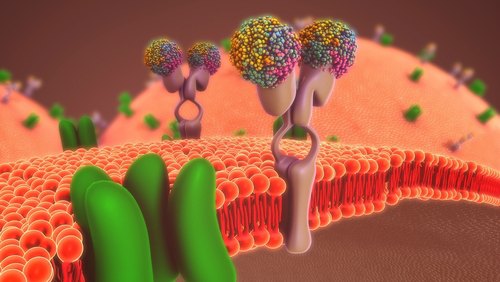
WebMD an infamous website that is supposedly funded by the pharmaceutical industry published an article in 2015 stating that ‘Statins linked to raised risk of Type II Diabetes based on a large Finnish study involving 9000 men without diabetes over the course of 6 years.
The men aged between 45-73 included 1 in 4 taking a statin drug at the beginning of the study and during the 6 years 625 men developed diabetes type II, compelling evidence that statin drugs have a strong causal association.
Researchers claim that the statin drug appears to increase a person’s insulin resistance and the drugs also impair the ability of the pancreas to secrete insulin..you might say it is a ‘Double edged sword’.
The 2 statins drugs used were Simvastatin (Zocor) and Atorvastatin (Lipitor).
The study report went on to say that statins decreased insulin sensitivity by 24% and insulin secretion by 12%.
According to the American Diabetes Association 29 million people in the US have diabetes type II.
I wonder how many take Statins ?.
The JUPITER trial evaluating Rosuvastatin in 2008 that involved 17,800 men and women (average age 66) found that there was a 26% higher incidence of diabetes.
Let us look at the mevalonate pathway again to establish what importance these prenylated proteins play in terms of biological processes specifically in terms of insulin.
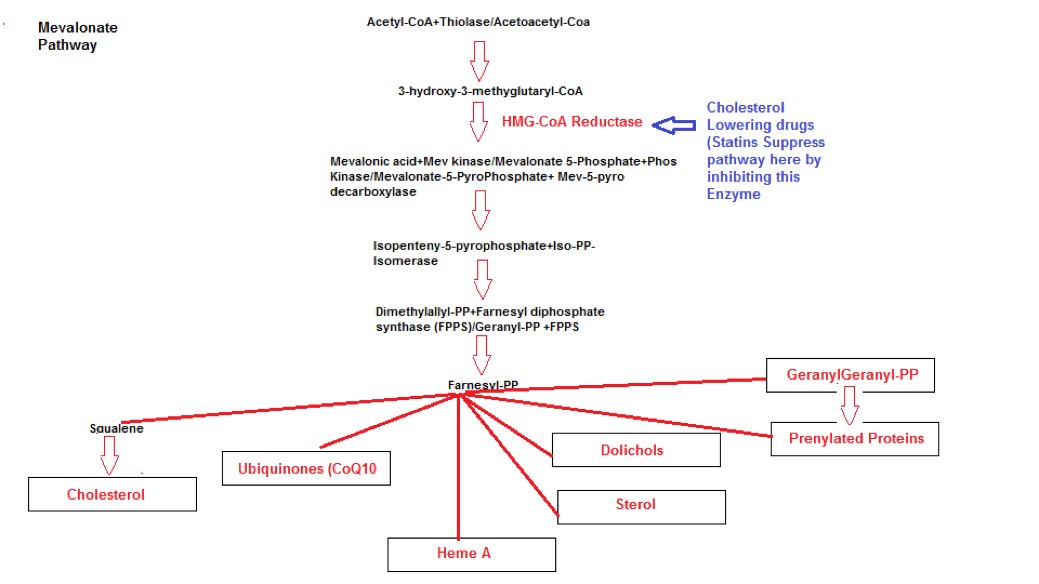
The secretion of insulin from the Pancreatic Beta cells (Islet cells) are regulated by the existence of glucose in the bloodstream, however, the molecular and cellular mechanisms involved in insulin secretion are Islet cell signaling proteins called G Protein coupled receptors (GPCR) that regulate communications within the cells and outside of the cells.
The secretion of insulin is stimulated by glucose (GSIS – Glucose stimulated insulin secretion) that is received by a Glucose Transporter GLUT2 which in turn activates ATP that changes the Potential difference (PD) of the cell.
This PD depolarizes the cell, closing the potassium channels and opening the calcium channels, and it is the accumulation of calcium that activates the insulin secretion.
When glucose levels fall in the blood to a predetermined level, this stimulates Glucagon release from the Pancreatic Alpha cells and it is this balance of insulin and glucagon secretion that maintains serum level glucose within a tight margin.
The signaling G Proteins undergo a type of post-translational modification, so the protein can anchor itself within the cell membrane.
These Prenylated modifications are achieved by protein precursors called GeranylGeranyl Pyrophosphate or Farnesyl Pyrophosphate which are added to the C Terminus cysteine of the protein (when a protein is translated from messenger RNA it is created using a string of amino acids that begin at N-Terminus string and finish at C-Terminus string).
Both these Pyrophosphates can be seen in the mevalonate pathway diagram above.
It is these modifications that are necessary for regulation for protein prenylation in Glucose Stimulated Insulin Secretion (GSIS) from the Pancreatic Islet Beta cells.
In other words these modifications are necessary to target modified proteins to specific membranous compartments to achieve optimal interaction with their effector proteins.
In 1993 Metz and coworkers discovered that inhibition of protein prenylation using the drug Lovastatin inhibits targeting and translocation of G Proteins to the cell membranes, and as a consequence, GSIS is attenuated at the beta cell islets, which means that insulin secretion is suppressed.
What did the researchers in the Finnish study say “Researchers claim that the statin drug appears to increase a person’s insulin resistance and the drugs also impair the ability of the pancreas to secrete insulin”.
This could be the explanation of why statin drugs can cause type II diabetes.
Heme A

If you look at the Electron Transport Chain (ETC) diagram again you will notice that Complex III and IV are referred to as Cytochrome b-c1 and Cytochrome c oxidase.
You will recall that energy for the cell is generated by electron transfer through the ETC by pumping protons from the mitochondria into the intermembrane space which then creates an electrochemical proton gradient across the membrane.
Each of the complexes are embedded in the inner membrane, where 3 are proton pumps, electrically connected by lipid and water soluble electron carriers.
Cytochromes are Heme proteins (containing iron) that are primarily responsible for ATP generation.
The cytochrome b-c1 is a monomeric (binding protein), and Cytochrome c oxidase is a larger enzymatic complex that catalyse redox (Oxidation-Reduction) reactions.
If electron transfer is suppressed or Heme A is suppressed, as is the case when statin drugs are introduced into the mevalonate pathway, complex III may begin to leak molecular oxygen resulting in Superoxide formation.
This was discovered in a 2015 study, mentioned in the introduction affecting lung cancer cells and with compromised antioxidant defense afforded by CoQ10 and the dolichols, the ETC becomes dysfunctional and thus mitochondrial dysfunction ensues.
You can appreciate that suppression of multiple products (CoQ10, Dolichols and Heme A) all play a part in mitochondrial dysfunction.
Organ Failures: Lung dysfunction
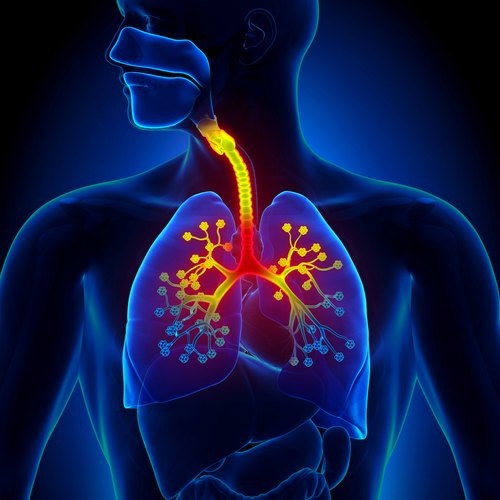
The Statin cholesterol lowering drugs are a class of drug that is described as `Amphiphilic` which means that they contain in their chemical structure both Hydrophilic (Water soluble) and Lipophilic (fat soluble) properties which allows them to breach the cell membrane to deliver the chemicals within the drug.
However this membrane breach degrades the lipids in the membrane so much so the cell wall deteriorates causing sodium to leak out and as a consequence the cell will lose energy.
Over time the cell will become more permeable.
Again, the problems all stem from mitochondrial dysfunction, specifically, the Electron transport chain interference because lung cells are vulnerable to oxidation damage since the lungs are responsible for taking in oxygen and transporting it to the bloodstream.
Smokers are also vulnerable since the lung capacity in terms of insufficient energy and a degraded cell wall is already compromised.
A review article that was published in 2008 by Fernandez et al, discusses an analogous relationship between the drug Amiodarone which is prescribed to treat Ventricular tachycardia (Ventricular Fibrillation) whose common side effects include Pneumonitis, Interstitial Pneumonitis and Pulmonary toxicity.
Organ Failures: Heart dysfunction
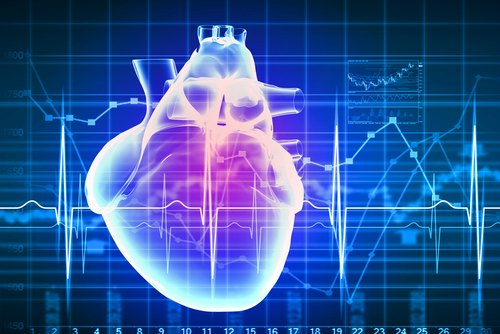
Not many people are aware, that Pharmaceutical companies are quite aware that statin drugs produce a negative effect on the heart muscle, because by inhibiting most of the mevalonate pathway, it actually depletes the heart’s main antioxidant Coenzyme-Q10.
In 1990 Merck patented a drug combination of Statin + Coenzyme-Q10, but they were never produced citing reasons of costs to include a drug and a vital nutrient together, and it appears that most statin prescribing physicians seem to be oblivious of at least prescribing Coenzyme-Q10 supplements, if they prescribe a statin drug to their patients.
This is not an excuse if physicians did their research, which most are quite capable of doing, then prescribing this vital nutrient would, by and large, neutralize the threat.
Alternative medicine practitioner Dr Whitaker filed a petition in May 2002 to the FDA to mandate a warning be included in the package inserts of all statin drugs complete with a ‘ Black Box’ warning that surround the mandated required text:
Warning: HMG CoA reductase inhibitors (statin drugs) block the endogenous biosynthesis of an essential cofactor, coenzyme Q10, required for energy production. A deficiency of coenzyme Q10 is associated with impairment of myocardial function, with liver dysfunction and with myopathies (including cardiomyopathy and congestive heart failure). All patients taking HMG CoA reductase inhibitors should therefore be advised to take 100 to 200 mg per day of supplemental coenzyme Q10.
Unfortunately the FDA ignored his petition.
I suppose patients prescribed the drugs would not bother to read the fine print on the package inserts, and if they did, they would think twice about taking the drug, and possibly this black box warning would leak out to the public domain, which could be detrimental to sales of these drugs.
Evidently money and profits are more important than people’s health…nothing new.
There was an article in 2016 in the Express newspaper in the UK concerning heart disease and Statin drugs, but what was interesting to read were the various reader comments which are shown below:
Reader comments from an article that was published in Jan 2016 in the UK Express newspaper called : Statins CAN cause heart disease – Shock research warns drug risks hardened arteries
Following a heart attack my husband was put on Atorvastatin. He ended up with peripheral neuropathy. His hands and feet were so painful, especially in cold weather he was nearly in tears. He also had other side effects including muscle pain and fatigue. They didn’t prevent him having another devastating heart attack which left him needing a heart transplant which they wouldn’t do because he was diabetic. Not long after coming home from hospital (3 months stay as an inpatient) his intestine ruptured causing severe internal bleeding and he died on the operating table. He had only just turned 57. I do believe that if he had not taken these devil drugs he might be alive today.
My hubby went to see his gp only he wasn’t there and had to see another….this gp mentioned his cholesterol ,(not the reason he went there anyway), she said I’ve got something to bring your cholesterol down….he said , let me guess, statins !! She said yes, he said he wasn’t going to take them…..his cholesterol was 5. something…..he went back a couple of weeks later and saw his own gp . he mentioned to him what the other one said and he said, you don’t need statins…..mine is higher than yours and i will not take them !! He said unbeknown to him his mother in law had been given them and when he saw her she was complaining she could hardly move…they talked and it came out she was put on them…..he told her to come off them and within a short while she was back to normal……doesn’t that make you think people !!!!! If not carry on taking them then and wait for the outcome
My GP was absolutely insistent that I should take statins – I couldn’t see the need. But she went on and on. I gave in. She prescribed SIMVASTATIN and within days my feet had swollen to elephantine proportions. Chronic constipation. Internal bleeding. And more besides – severe pain in both legs which is still keeping me crippled years later. None of which I had ever experienced before. I looked up the Internet and there was SIMVASTATIN side effects and everything else, I put on my slippers, crossed the road to her surgery and told her what had happened. Dismissively she said:” Oh really? Nobody else has ever complained.” Then I related the Internet list of the warnings against Simvastatin none of which she knew. BEWARE! I have been bedridden with pain ever since …
Cholesterol Blood Test
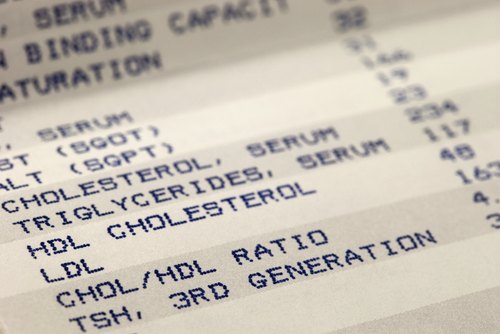
In the UK and Australia physicians use mmol/litre and the US use mg/decilitre to measure cholesterol.
According to the ‘experts’, US citizens are warned to maintain their cholesterol levels below 200mg/dl and their LDL below 100 mg/dl.
In the UK, guidelines stipulate less than 5 mmol/l for total cholesterol and less than 3 mmol/l for LDL.
Although the National Institute for Clinical excellence (NICE) state:
“A target for total cholesterol or low-density lipoprotein (LDL) cholesterol is not recommended for primary prevention of cardiovascular disease.” The basis for recommendation is summarised as follows: “The National Institute for Health and Clinical Excellence (NICE) does not recommend the use of target levels of cholesterol for people taking statins for primary prevention of cardiovascular disease. This is because it found no clinical trials in primary prevention that have evaluated the relative and absolute benefits of achieving different cholesterol targets in relation to clinical events.”
In the US : To convert mg/dl to mmol/l divide by 38.66: UK figures:
Total Cholesterol = 200 mg/dl = 5.17mmol/l (5 mmol/l)
LDL = 100 mg/dl = 2.58mmol/l (3 mmol/l)
So the figures agree with each other, There is another measurement which is the total Triglycerides, so physicians will measure cholesterol using the following formulae:
Total Cholesterol = LDL +HDL+Triglycerides/5
I have attempted to discover what relevance the above numbers and formulae have on high or low cholesterol and then to single out what needs to be lowered,
From a previous article in this series you know that LDL is a watered down version of the original VLDL, packaged together from the liver and its job is to deliver cholesterol to body sites that need it.
Whereas the HDL is responsible for scooping up excess cholesterol to ship it back to the liver.
I have already stated that LDL levels remain fixed for a period of days, weeks, months depending on the need for cholesterol distribution.
These LDL levels are also independent of dietary cholesterol or the amount of VLDL manufactured.
It is important to state here that the liver without being interfered with by a drug produces approx 3000 mg of cholesterol every day give or take depending on the dietary uptake.
The liver will make more if the dietary intake is low, or less if the dietary intake is high.
The liver very efficiently regulates cholesterol manufacture and distribution very efficiently.
I also pointed out that Total cholesterol that is being measured, varies every day like blood pressure, so one blood test, one snapshot in time is not going to be very helpful especially if the result hinges on you being prescribed a drug possibly for life.
Someone questioned that when cholesterol is measured:
“are they measuring the total molar mass of all lipoproteins in the blood, and if so, can they distinguish what is cholesterol, lipids or proteins”.
From a great article by Dr Zoe Harcombe she quotes from a Biochemistry book by Garrett & Grisham the following:
- VLDL is approximately 50% triglyceride, 22% cholesterol, 18% phospholipids and 10% protein.
- LDL is approximately 8% triglyceride, 45% cholesterol, 22% phospholipids and 25% protein.
- HDL is approximately 4% triglyceride, 30% cholesterol, 29% phospholipids and 33% protein.
So Dr Harcombe asks the question
“Is the blood cholesterol measurement related to the cholesterol in each lipoprotein or is it the whole lipoprotein?”
We have already established that excessive Carbohydrates not only increase glucose but cholesterol is also increased.
I would also submit that what is meaningful is the number of LDL particles floating in the blood, and if high then this may be a sign of excess inflammation occurring in the body, since the liver is being signaled to manufacture more cholesterol for repair purposes to multiple locations.
So in summary measuring the number of LDL particles in the blood is more meaningful than measuring total cholesterol, which it is not, since cholesterol cannot flow in a water based medium like blood.
Unless your physician can enlighten you on the significance of the lipid panel, and indeed the relevance of one snapshot measurement in time, then I would think twice in accepting anything that he/she might want to prescribe you, especially prescribing a drug based purely on age which is nonsense.
The majority of physicians are ignorant concerning physiological ageing.
Test their knowledge, does Alpha Lipoic Acid (ALA) or Pyrroloquinoline Quinone (PQQ) have any bearing toward ageing. ?.
Remember what I said in a previous article, a physician told me back in 2007 that cholesterol limits equate to 200 + your age, so a 60 year old man with a cholesterol level of 260 mg/dl is perfectly normal, and I ask the question AGAIN unless something drastic has happened within the human race, why has acceptable cholesterol levels been lowered to 200.
Dr Malcolm Kendrick in his book ‘The great cholesterol con’ also states that 20 years ago ( his book was published in 2008, so its nearly 11 years ago) GP’s in the UK would only get excited if your total cholesterol was above 7 mmol/l, and 10 years ago anything above 6.5 mmol/l would put you in the treatment zone.
Today what is considered required treatment level is 5 mmol/l.
What is driving these guidelines ?, if not only to create more potential ‘Statin Patients’.
I have no knowledge of any study that has been executed to justify lowering the cholesterol threshold levels, in fact the Jupiter (Justification for the Use of Statins in Primary Prevention: an Intervention Trial Evaluating Rosuvastatin trial) clinical trial that was performed to prove that statins reduce heart attacks evaluating 17,802 patients failed.
Careful analysis of the Jupiter data showed that Patients given the Statin drug there were 12 deaths from heart and stroke events, and in the Placebo group there were also 12 deaths from heart and stroke events.
Having said that the statin users suffered 22 non fatal heart attacks, while the placebo group suffered 62 non fatal heart attacks so did the trial achieve its objectives in terms of reducing heart attacks ?, by definition, Yes.
Hypothesis
It is the belief of Stephanie Seneff researcher at MIT that in the short term Statin medication are able to prevent small cardiovascular events such as strokes caused by blood clots.
It is able to achieve this by disguising itself as cholesterol suphate which like statins are biophysically similiar, both of which contain a hydrophillic core, that has an affinity to water and has Kosmotropic ( causes water molecules to favourably react) negatively charges ions that are attached.
This scenario is beneficial to the membranes of red blood cells.
Instead of cholesterol sulphate ( normally generated by sun exposure ) filling up the membrane, building structured water, causing the red blood cells to repel each other, and thus they don’t coagulate, the active ingredient in the statin drug replaces the cholesterol suphate that provides the same benefits.
Longer term consumption of Statins is where the trouble starts as we have discussed before.
Red yeast rice
Red rice, that gets its red color from its Anthocyanin ( A Flavonoid that provides an Antioxidant effect) content. The rice is then fermented using Monascus purpureus. a type of Yeast, and the secondary metabolites from this yeast fermentation process produce monacolin j and K, known active ingredients.
This is known as Red yeast Rice which is used in China for culinary purposes as a food colouring or as a traditional remedy to promote digestion and blood circulation.
However, western pharmacuticals use Red Yeast Rice as an ingredient in cholesterol lowering drugs ( the Statin family), since it was discovered that an active ingredient possibly Monacolin, when ingested is rapidly converted from their natural Lactone ( hydroxy acid esters) form to an identical hydroxy acid which inhibits 3 Hydoxy-3 methylglutaryl coenzyme A(HMG-CoA).
This in turn interferes with the main enzyme in the Cholesterol manufacturing Mevalonate pathway called HMG-CoA Reductase lowering cholesterol production among other products.
What we don’t know is, what other ingredients are contained with these synthetic Statin drugs.
In terms of dosage, Statin drugs that also contain Monacolin offer a range of 10-80mg/day. Chen at al 2013 in their study confirmed 5-6 mg of Monacolin K was bioequivalent to 20-40mg of Lovastatin.
If we consider that in another study it was found that 3 mg/day of Monacolin K using Red Yeast Rice was able to reduce Cholesterol by 11.2% and LDL levels by 14.8% using patients with the genetic high cholesterol condition Familial Hypocholesterolemia.
However, the European Food safety Authority (EFSA) reported in 2018 that the profile of adverse events to Red Yeast Rice is similar to Statins ( Lovastatin) taken from 4 case reports ( WHO, ANSES, Italian Surveillance and the FDA). Adverse events targeted Musculoskeletal and connective tissue ( 29-37.2%, incl 1-5% Rhabdomyolysis), liver (9-32%), nervous system (12.8-26.9%), gastrointestinal tract ( 12-23.1%) and skin/subcatenous tissue ( 8-17.3%)
Case reports also identified advsere events such as Rhabdomyolysis, Hepatitis and skin disorders occurred from an intake of 3 mg/day of Monacolin K, from Red Yeast rice.
Statins for Children and Pregnant Women

Up to now I have been fairly neutral in my approach to these articles on cholesterol lowering drugs, but any physician who targets kids to push their drugs should be put in jail.
There excuse, to treat obesity.
Blocking their cholesterol levels is not only foolish but ignorant because these ‘Children’ have not lived long enough to create a cholesterol problem.
Because this perpetual habit of drugging symptoms and not analyzing the root cause is just malpractice, and don’t tell me that they don’t have the time to find the cause..find the time, especially for children and young teens that are starting out in life..foolish and impetuous…but still special to every mother.
This specifically concerns the psychiatrists who drug children instead of recommending behavioural correction or indeed physiological correction, I.e fixing the microbiome imbalance.
As I said before, Obesity is a nutrient deficiency, and obese anybody is desperately trying to eat their way out of a nutrient deficiency, yes their cholesterol is increasing, but like I said before, excess carbs will do that, since insulin also turns on the HMG-Coenzyme A Reductase enzyme, but suppression is going to cause cellular degradation..in a teenager.??.give me break.
Equally heinous is the smart ass who is going to prescribe a Class X drug..yes statins are Class X, like Thalidomide was in the 60s, a so called harmless drug prescribed for morning sickness caused innumerable horrible birth defects in 46 countries; 10,000 babies alone in Germany.
The FDA did the right thing by keeping the thalidomide drug out of the US.
In terms of statins, the FDA have also done the right thing and issued a warning as in the following quote from the website Healthline:
The U.S. Food and Drug Administration (FDA) says that statins are not recommended for pregnant women. They are rated as “Pregnancy Category X” drugs, which signifies that studies have shown they may cause birth defects and that the risks clearly outweigh any benefit.
So take heed all you physicians out there, that are just about to prescribe statins to a mother-to-be..DON’T. Take heed all you new mothers-to-be DON’T take any cholesterol lowering drugs because you are putting your baby at risk of potential birth defects..just listen to the FDA for once.
Final Words

“In America, we no longer fear God or the communists, but we fear fat.” -David Kritchevsky
The fact that in 1988, the US Surgeon General wanted to establish once and for all the dangers of dietary fat, and the scientific task appeared to be straightforward.
At the same time, the NIH announced to the world that we should all restrict fat intake and the AHA (American heart association) told Time magazine that if everyone complied we will have atherosclerosis conquered by 2000.
The Surgeon General’s office had just published a 700 page landmark report declaring fat to be the most unwholesome component of the American diet.
Eleven years later, the grand study and final report on ‘fat is the devil’ that was initiated in 1988, was abandoned in June 1999.
The letter of explanation that was circulated stated that:
“we did not anticipate fully the magnitude of the additional external expertise and staff resources that would be required”.
In other words they were wrong to have such preconceived opinions and conclusions, but above all, their preconceived science was not stacking up.
Unfortunately there are still millions out there in fear of their life if they eat more than 6 eggs/week and run to their doctor to ask permission to eat a steak this week.
It is the same ‘Sheeple’ thinking in terms of cholesterol lowering, fear mongering and selling sickness on behalf of the medical community.
I would like to add some text here taken from Dr Malcom Kendrick’s great book ‘Doctoring Data’ where he received an email from a journalist suggesting that the American guidelines on Heart disease treatment are moving away from lowering cholesterol, and asking if the UK cardiology hierachy are raising any questions about cholesterol hypothesis.
Dr Kendrick replied :
” When the dam bursts, all the cardiologists will claim they never believed in the cholesterol hypothesis. Its all inflammation dontcha know. As for now, first to break ranks gets shot”
I will end on a lighter note

Game Show Host (John Cleese) : Good evening and welcome to Stake Your Claim. First this evening we have Mr Norman Voles of Gravesend who claims he wrote all Shakespeare’s works. Mr Voles, I understand you claim that you wrote all those plays normally attributed to Shakespeare?
Voles (Michael Palin) : That is correct. I wrote all his plays and my wife and I wrote his sonnets.
Host: Mr Voles, these plays are known to have been performed in the early 17th century. How old are you, Mr Voles?
Voles: 43.
Host: Well, how is it possible for you to have written plays performed over 300 years before you were born?
Voles: Ah well. This is where my claim falls to the ground.
Host: Ah!
Voles: There’s no possible way of answering that argument, I’m afraid. I was only hoping you would not make that particular point, but I can see you’re more than a match for me!
Host: Mr Voles, thank you very much for coming along.
Voles: My pleasure.
Host: Next we have Mr Bill Wymiss who claims to have built the Taj Mahal.
Vymiss (Eric Idle) : No.
Host: I’m sorry?
Wymiss: No. No.
Host: I thought you cla…
Wymiss: Well I did but I can see I won’t last a minute with you.
Monty Python sketch: Stake Your Claim
Check out the Previous Article in this series:
https://www.extremehealthacademy.com/selling-sickness-part-1-conventional-medicine-is-a-business/
https://www.extremehealthacademy.com/selling-sickness-part-2-profits-before-health/
https://www.extremehealthacademy.com/selling-sickness-part-3-baffling-the-masses/
https://www.extremehealthacademy.com/selling-sickness-part-4-prostaglandin-drugs/
https://www.extremehealthacademy.com/convential-medicine-part-5-the-business-of-antidepressants/
https://www.extremehealthacademy.com/selling-sickness-part-6-cholesterol-lowering-drugs-part-1/
https://www.extremehealthacademy.com/selling-sickness-part-7-cholesterol-lowering-drugs-part-2/
References/Acknowledgments:
- The cholesterol myth Book by George Mann MD
- The great cholesterol con Book 2008 by Dr Malcolm Kendrick
- Statins linked to raised risk of type 2 diabetes Dennis Thompson March 2015 WebMD
- Protein Prenylation in glucose induced secretion for the pancreatic islet Beta cells Anjaneyulu Kouluru Jan 2008 NCBI
- Mevalonate pathway blockade,Mitochondrial dysfunction and Autophagy a possible link Paulo Tricarico, Sergio Cravella, Fulvio Celsi 2015 International Journal of Molecular sciences
- Amiodarone Drugs.com
- Cardiologists overlook lifesaving discovery 2004 William Faloon LifeExtension Magazine article
- Statins linked to lower aggression in men and higher in women UC San Diego Health Scott LaFee July 2015
- Scientific opinion on the safety of Monacolins in red yeast rice EFSA Maged Younes, Peter Aggett et al 2018
- Interview transcript between Dr Mercola and Stephanie Seneff MIT Oct 15 2012
- Stake your claim Matts Monty Python’s repository
- Statins and Myoglobin: How muscle pain and weakness progress to heart, lung and Kidney failure 2010 Paper authored by Stephanie Seneff MIT
Author: Eric Malouin